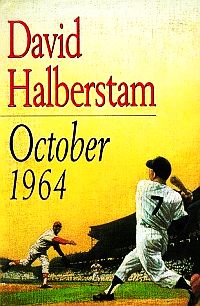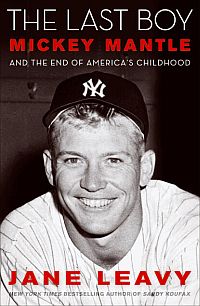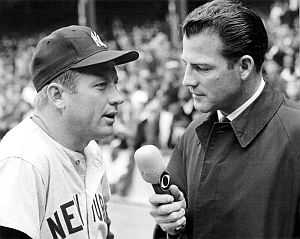It was mid-September 1965. America was in an unsettled time, as the Vietnam War and civil rights unrest were part of an unhappy national scene. Yet life went on. “Help,” by the Beatles, was the No. 1 hit on the Billboard pop music chart; The Sound of Music was leading the film box office; and James Michener’s The Source was atop the New York Times fiction bestsellers list. In August, President Lyndon B. Johnson signed the Voting Rights Act into law, but several days later the Watts Riots began in Los Angeles, underscoring the nation’s racial strife. However, on September 18th at New York’s Yankee Stadium, much of the outside world was suspended, if only briefly, as more than 50,000 baseball fans cheered their hero, Mickey Mantle, the famed slugger of the New York Yankees. It was “Mickey Mantle Day.”
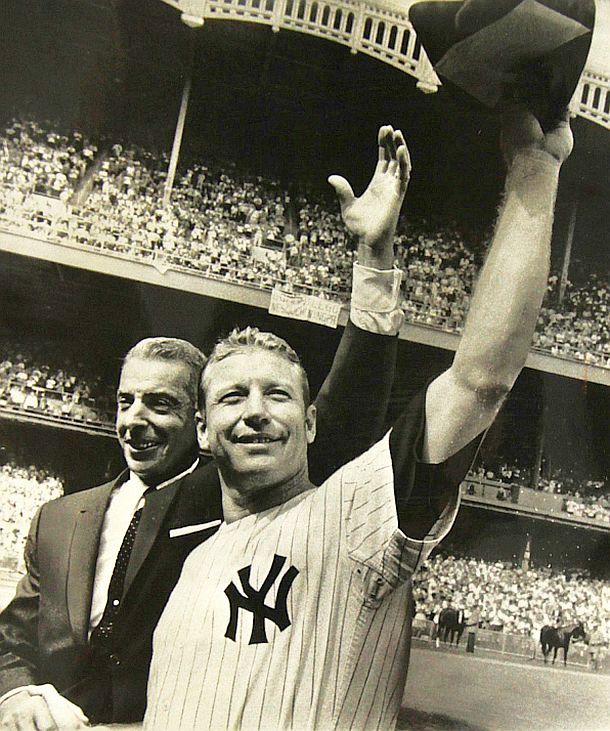
Sept 18th, 1965: Former Yankee, Joe DiMaggio, presents Mickey Mantle to some 50,000 fans at Yankee Stadium on “Mickey Mantle Day” in New York. Mantle would also play his 2,000th game that day. AP photo.
Mantle, 33, was then in his 15th year with the Yankees. In June that year, Yankee management feared Mantle might be nearing the end of his playing days so they decided to give him a special day at the stadium. Only four other Yankees had been so honored – Babe Ruth, Lou Gehrig, Joe DiMaggio and Yogi Berra. Mantle, who had played his entire career with the Yankees, had been a key player since his arrival as an 19-year old rookie in 1951. He had won three American League MVP Awards, a Triple Crown in 1956, and had made 14 All-Star appearances. He also figured prominently in the team’s World Series appearances. A fan favorite, Mantle was adored in New York and generally loved throughout the baseball world.
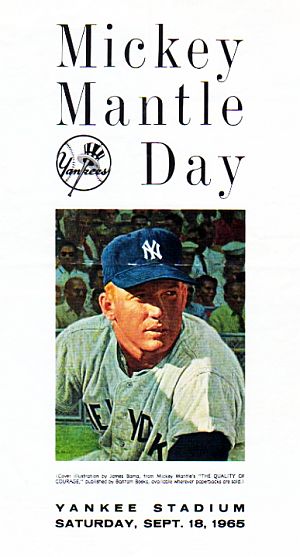
Portion of the cover of special program booklet issued by the New York Yankees for “Mickey Mantle Day.”
At Yankee Stadium on September 18th, the ceremony honoring Mantle began at 1:00 pm, about an hour before a scheduled game with the Detroit Tigers. Famed announcer, Red Barber was master of ceremonies. Along with Mantle on the field that day, were his wife, Merlyn, and his eldest son, Mickey,.Jr, with three other sons watching from home. Among attending VIPs that day was U.S. Senator Robert F. Kennedy (D-NY).
The Yankee organization had issued a special program for the day, with a centerfold of pages and photo collage devoted to Mantle and his career. And as was then the custom with such “special days” honoring national athletes, a cascade of gifts from fans, businesses, and organization were bestowed on Mantle and his family – though at the time Mantle was the highest paid player in Major League baseball.
Joe DiMaggio presented Mantle to some 50,000 fans at Yankee Stadium that day.“I am proud and honored to introduce the man who succeeded me in centerfield here in 1951,” said DiMagio. “He lived up to all expectations and there is no doubt in my mind that he will one day be in the Hall of Fame.”
Mantle then moved to the microphone to make his remarks, paying homage to DiMaggio, saying, “I think just to have the greatest baseball player I ever saw introduce me is tribute enough for me in one day.” Acknowledging that he was nervous, he generally thanked those who helped him through his career, saying he hoped he’d lived up to their expectations. “To have any kind of success in life I think you have someone behind you to push you ahead and to share it with you…. And I certainly have that,” he said, acknowledging his wife Merlyn, his four boys, and his mother, in attendance that day with Merlyn and young Mickey.

Mickey Mantle making remarks at “Mickey Mantle Day,” Sept 18th, 1965.
Then he closed his remarks, noting: “There’s been a lot written in the last few years about the pain that I’ve played with. But I want you to know that when one of you fans, whether it’s in New York or anywhere in the country, say ‘Hi Mick! How you feeling?’ or ‘How’s your legs?,’ it certainly makes it all worth it. All the people in New York, since I’ve been here, have been tremendous with me. Mr. Topping, all of my teammates, the press and the radio and the TV, have just been wonderful. I just wish I had 15 more years with you….”
Rough Year
However, in 1965, Mickey Mantle was having a rough time of it, especially earlier in the season. He was not at his best. In fact, in June that year, he was hurting with injuries and slumping, batting only .240. Not happy with his performance, Mantle at the time thought about quitting. But he persevered, nonetheless, and made a bit of comeback, though still underperforming his then lifetime .308 average. He had also been moved from his traditional centerfield position to the somewhat less demanding left field.
In mid-August that year, Yankee manager Johnny Keane remarked on Mantle’s season: “Mickey has played at half-mast most of the season. But now, I’m seeing him at his best. He may not admit it, but he has cut down on his swing and still hits some real good shots. And when he does, the whole team brightens up. He’s the leader, no doubt about it, and he always wants to play.”
Two years earlier, in 1963, Mantle broke a bone in his left foot in a game against Baltimore, and played only 65 games that year. But in 1964, he came roaring back, playing in 143 games with 34 home runs and 111 runs batted in, compiling a .303 average. In the 1964 World Series, although the Yankees lost to the St, Louis Cardinals, Mantle hit for a .333 average with three home runs, eight RBIs, and eight runs scored. Mantle’s three home runs in that Series, however, raised his World Series total to a record-setting 18, surpassing Babe Ruth’s mark of 15.
In addition to the World Series home run record held by Mantle, his other World Series records include: most RBIs (40), most extra-base hits (26), most runs scored (42), most walks (43), and most total bases (123).
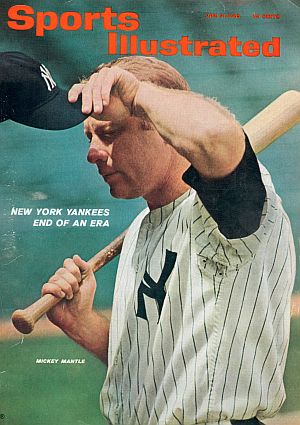
1965: Mickey Mantle on the cover of Sports Illustrated, with story speculating about the demise of the Yankees.
A Sports Illustrated magazine piece that ran a few months prior to Mickey Mantle Day, on June 21, 1965, had featured Mantle on its cover with the tagline, “New York Yankees, End of An Era.” The story focused on the possible end of the Yankee dynasty that had dominated the game, owed in part to the ebbing careers of “big men” players like Mantle. But in the piece, author Jack Mann noted how an injured Mantle amazed his competitors with his continued play:
…Mantle, the one-man orthopedic ward, is even more a symbol of the Yankees in crisis than he was in their predominance. He plays on, on agonized legs that would keep a clerk in bed, and the opposition wonders how. “He’s hurting worse than ever,” says [former Yankee] John Blanchard…, “but he won’t admit it.”
“I don’t see how the heck he can keep going,” says Baltimore’s Norm Siebern, another ex-Yankee. ‘It has to be his last year,’ an American League manager concluded after watching the 33-year-old Mantle for the first time this season. ‘He can’t go on that way.’
But he did go on – for another three seasons in fact. His production was down in those years, cut in half from what he did in his prime. Still, he hit .288 in 1966 and played in more than 140 games in each of 1967 and 1968. And over those three years he continued to hit home runs – 23 in 1966, 22 in 1967 and 18 in 1968, with more than 50 RBIs in each of those years. He finished with a lifetime batting average just under .300, at .298 over 18 years. In that span he played in more than 2,400 games with a career total 536 home runs and 1,509 RBIs.
|
“A Macho Thing” David Halberstam, the famous American journalist, in his book, October 1964, chronicles the respective 1964 World Series-bound seasons of the New York Yankees and St. Louis Cardinals. In the excerpt below, he recounts one of Mickey Mantle’s home runs, and a bit of baseball’s home run lore, beginning with an August 1964 game at Yankee Stadium with the Chicago White Sox: “…In the fourth inning Mantle came up with the right handed Ray Herbert pitching for Chicago, and hit a tremendous drive to center field. The wind was blowing out slightly, and at first Mantle did not think he had quite gotten all of it. A look of disgust came over his face… [and he came] very close to throwing his bat down… Gene Stephens, the center fielder, thought at first that he could make a play on the ball, and then as he went back he saw the ball carry over the monuments, over the 461 [foot] sign, and over the screen, which was thirty feet high there. It landed fifteen rows back, and since each row was judged to be two feet, the ball was officially judged to be 502 feet [from home plate]. It may have been the longest ball Mantle ever hit to center field in the Stadium……Mantle was relaxed after the game, almost boyishly happy.”I’m glad I didn’t bang my bat down,” he told the assembled reporters. He loved the tape -measure home runs – they were his secret delight in the game. The reporters who covered him were aware of this, and knew how relaxed and affable he would be in the locker room after he hit one… …Again and again when Mantle was younger, [former Yankee manager, Casey] Stengel had tried to get him to cut down on this swing, telling him that he was so strong, the home runs were going to come anyway, and they did not need to be such mammoth shots; if he cut back on his swing, his batting average would go up dramatically. That made no impression on Mantle, for he loved the tape-measure drives; he loved just knowing that every time he came to bat he might hit a record drive; he loved the roar of the crowd when he connected, and was equally aware of the gasp of the crowd when he swung and missed completely, a gasp that reflected a certain amount of awe… 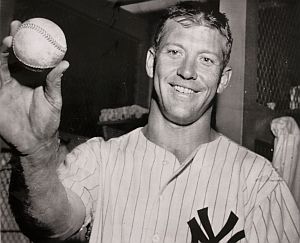 Mickey Mantle holding a home run ball he hit some years earlier at Yankee Stadium in a July 1957 game that traveled an estimated 465 feet. ____________________ Note: Mantle in the August 1964 Chicago game mentioned above had two home runs, one from each side of the plate, the 10th time in his career he had accomplished that switch-hitting feat. |
Back at “Mickey Mantle Day” in September 1965… As the scheduled game got underway that day, the pitcher for Detroit Tigers was a young right hander named Joe Sparma. When Mantle came up to bat in the bottom of the first inning, with two outs, he received a thunderous ovation from the crowd that day at Yankee Stadium. But then, Tiger pitcher Joe Sparma undertook something of a classy gesture to honor his Yankee opponent. He stepped off the mound, walked to home plate, and shook Mantle’s hand in admiration, saying to him: “You know, I’ve never had a chance to meet you in person, and I’ve always admired you.” Sparma then walked back to the mound and Mantle hit a long drive to left field for an out. Sparma had Mantle’s number that day, striking him out in the third inning and forcing a ground out in the 6th. Reportedly, Mantle, after his strike out, grumbled to the catcher as to why the Tigers couldn’t have been more considerate on his special day. Mantle walked his 4th time up that day, after Denny McLain came in to relieve Sparma. Tigers won, 4-3.
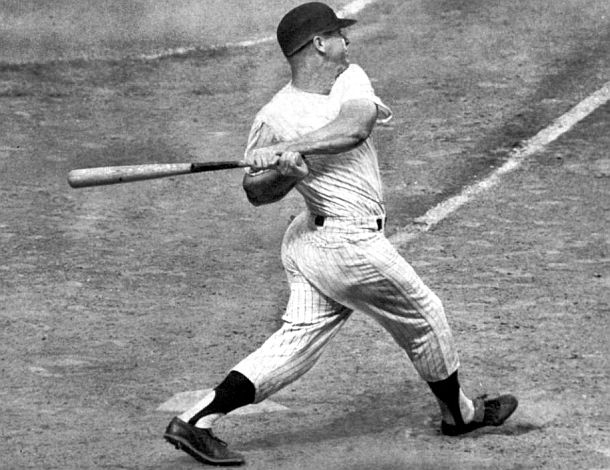
1964: Switch-hitting Mickey Mantle of the New York Yankees showcasing his powerful swing from the left side.
Mickey Mantle announced his retirement from the New York Yankees on March 1st, 1969. He was 38 years old. His jersey and No. 7 numeral were retired at a ceremony on the second Mickey Mantle Day on June 8th, 1969. Mantle would return to the ballpark on various special occasions and “Old Timers” games in the 1970s and 1980s. After a battle with liver cancer, Mickey Mantle died on August 13th, 1995. He was 63 years old.
The one footnote about Mickey Mantle, however – and some will say there is more than one – is that he might have had an even greater baseball career were it not for his injuries, but also, were it not for his carousing and use of alcohol, especially while he played. This behavior, some say, was due in part to Mantle’s fear he would die at a young age, as his father had, at age 40, from Hodgkin’s Disease.Mantle did acknowledge his abusive behavior in his final, dying days, when modern medicine could no longer do anything for him, saying at a public press conference that he should have “taken better care of myself,” aiming his remarks at the young and advising them, “don’t be like me.” Still, for many, despite Mantle’s failings and the mythology surrounding his career, good and bad, he remains a much loved baseball superstar, perhaps captured best in the title of Jane Leavy’s 2010 book on him, The Last Boy.
Additional Mickey Mantle stories at this website can be found at the “Baseball Stories” topics page. See also “The M&M Boys,” on the Mantle-Roger Maris home run race of 1961, and the “Annals of Sport” page for other sports stories. Thanks for visiting – and if you like what you find here, please make a donation to help support the research and writing at this website. Thank you. — Jack Doyle
|
Please Support Thank You |
____________________________________
Date Posted: 20 June 2016
Last Update: 19 September 2019
Comments to: jdoyle@pophistorydig.com
Article Citation:
Jack Doyle, “Mickey Mantle Day: Sept 18th, 1965,”
PopHistoryDig.com, June 20, 2016.
____________________________________
Sources, Links & Additional Information
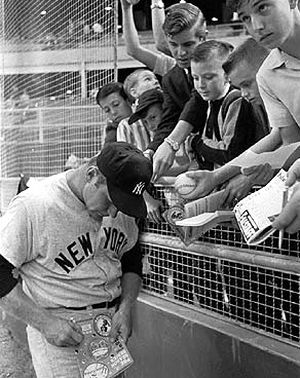 1965: Mickey Mantle of the New York Yankees signing autographs for young fans in Houston, Texas. |
“Mickey Mantle Day,” MickeyMantle.com.
“Mickey Mantle Speech, Mickey Mantle Day,” The Mick.com.
Associated Press, (New York) “Mantle’s Pay For 1965 Put at $107,000,” The Morning Record (Mariden, CT), February 5, 1965, p.4.
Frank Eck, AP Newsfeatures, Sports Editors, “Mantle Turns to Football to Aid His Career” (and MM Day), The Free Lance-Star (Frederickburg, VA), September 9, 1965, p. 19.
UPI, (New York), “Wagner Proclaims Today A Special Day For Mantle,” Lodi News-Sentinel, September 16, 1965.
Arthur Daley, “Sports of The Times: A Day for Mickey,” New York Times, September 17, 1965.
Arthur Daley, “Sports of the Times: The Nervous Hero,” New York Times, September 18, 1965.
Jack Mann,” Decline and Fall of a Dynasty; A 44-Year Saga of Power and Glory Is Ending for the New York Yankees…,” Sports Illustrated, June 21, 1965.
Milton Richman, UPI, “Mickey Mantle Day Was A Huge Success,” The Times-News (Hendersonville, NC), September 20, 1965, p. 3.
“Mickey Mantle & Joe Dimaggio at Yankee Stadium – 1965” (Mickey Mantle Day, September 1965)YouTube.com, Time, 1:53.
Loudon Wainwright / The View From Here, “A Vulgar Tribute to Greatness,” Life, October 1, 1965, p. 25.
“Mickey Mantle Stats,” Baseball-Almanac .com.
James Lincoln Ray, “Mickey Mantle,” Society for American Baseball Research.
“The Last Boy,” JaneLeavy.com.
_______________________________
